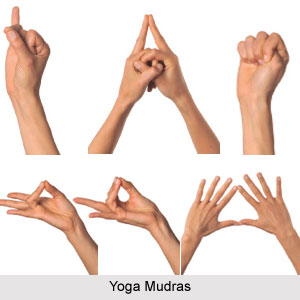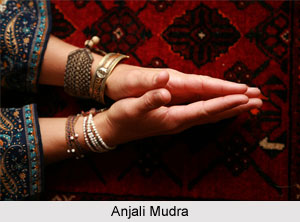 Mudras or hand gestures are used extensively to communicate in dance and other art forms. The science of Mudras is also based on the retention and maintenance of the natural balance in our lives. A healthy existence is always desired and Mudra in therapeutic use defines a feeling of `wellness`. Thus Mudras have a beneficial effect on the mind and the body of a human being. However, Mudras, similar as Yoga must be practiced sincerely and after attaining full knowledge of them. Mudras are natural process of healing from any ailment or disease. Tradition says that the body, mind, and soul are inherent to every fingertip, every finger joint in each individual finger, and naturally also in the entire hand itself.
Mudras or hand gestures are used extensively to communicate in dance and other art forms. The science of Mudras is also based on the retention and maintenance of the natural balance in our lives. A healthy existence is always desired and Mudra in therapeutic use defines a feeling of `wellness`. Thus Mudras have a beneficial effect on the mind and the body of a human being. However, Mudras, similar as Yoga must be practiced sincerely and after attaining full knowledge of them. Mudras are natural process of healing from any ailment or disease. Tradition says that the body, mind, and soul are inherent to every fingertip, every finger joint in each individual finger, and naturally also in the entire hand itself.
Mudras are easy to practise as they are free from negative elements. According to the science of Mudra, the five fingers of the hand correspond to the five natural elements. The thumb is associated with `Agni` or fire, the index finger with `Vayu` or air, the middle finger with `Akash` or ether or space, the ring finger with `Prithvi` or earth and the little finger with `Jal` or water. A great influence on every area of the body is rendered through the fingers and hands. It is believed that the physical level is associated with material energy.
A reference of the basic qualities of Mudras is found in the ancient health systems. It is on the concept that a balance of the five elements in the body is maintained by the tips of the fingers. Each fingertip possesses energy corresponding to these five elements and by connecting various fingers to each other in different gestures help in balancing these elements in the body.
The mudra therapy is considered to be five thousand years old. Much knowledge of the Mudras in therapeutic use is rooted in ancient texts however this knowledge is often twined with religion. Mudra therapy is a complementary therapy and can be practised side by side with any regular therapy. The therapeutic use of Mudras can be classified with popular therapies such as Acupressure, Naturopathy, Pranic healing and Reiki. According to traditional healing process there are seventy to eighty Mudras used for therapies.
A wide variety of Mudras in therapeutic use are found. Mudras such as Pran mudra, the Vayu mudra, the Shunya mudra, the Shankh mudra, the Prithvi mudra and the Varun Mudra are used for therapies. Each of these mudras can be practised to relive conditions ranging from a simple cold to chronic disorders. Although researches say that the healing process is not instant but a strong believe of getting well can be equally effective.
 Apart from the basic Mudras, there are some variations of Mudras in Therapeutic use that can be several combination ones. Mudras used for therapies can be practised in five-minute sessions over the day. There are certain specific mudras, which are practised for certain particular disorders. The sitting posture is also considered to be associated with each of the mudras. The sitting position in Padmasana or Sukhasana is recommended.
Apart from the basic Mudras, there are some variations of Mudras in Therapeutic use that can be several combination ones. Mudras used for therapies can be practised in five-minute sessions over the day. There are certain specific mudras, which are practised for certain particular disorders. The sitting posture is also considered to be associated with each of the mudras. The sitting position in Padmasana or Sukhasana is recommended.
Mudras can be practised at any time and with both the hands with the palms facing the sky. The left hand mudras are beneficial for the right side of the right hand Mudra helps recovering the left side of the body. Once the condition of the body is properly analysed, one may choose the relevant mudra to improve the condition. There are a range of common Mudras such as the Pran mudra which is good for building up health and vitality and is used for good eyesight. The Apanavayu mudra strengthens the heart and the digestive system. The Sankh mudra builds up aura in the body. The Pustak mudra enables one to build up concentration. Mudras in therapeutic use regulate every part of one`s mind and body, enhance the thought processes and change the outlook of life.
Mention of Mudras in therapeutic use was extensively found in the ancient times and these Mudras helped to communicate, to heal and to maintain mental and physical wellness.




















